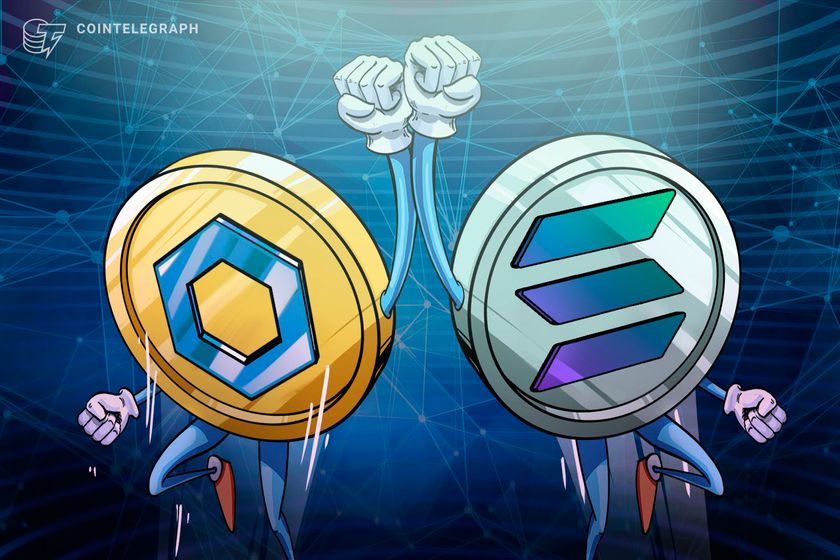

Despite growing tariff-related uncertainty, there is a 70% probability cryptocurrency markets will find the local bottom in the next two months, which will serve as the supporting foundation for the next leg up in the 2025 cycle, according to Nansen analysts.
Savvy traders continue making generational wealth despite growing volatility and lack of risk appetite. One unidentified trader turned an initial $2,000 investment into over $43 million by trading the popular frog-themed memecoin, Pepe.
70% chance of crypto bottoming before June amid trade fears: Nansen
The cryptocurrency market may see a local bottom in the next two months amid global uncertainty over ongoing import tariff negotiations, which have been limiting investor sentiment in both traditional and digital markets.
US President Donald Trump on April 2 announced reciprocal import tariffs, measures aimed at reducing the country’s estimated trade deficit of $1.2 trillion in goods and boosting domestic manufacturing.
While global markets took a hit from the first tariff announcement, there is a 70% chance for cryptocurrency valuations to find their bottom by June, according to Aurelie Barthere, principal research analyst at the Nansen crypto intelligence platform.
The research analyst told Cointelegraph:
“Nansen data estimates a 70% probability that crypto prices will bottom between now and June, with BTC and ETH currently trading 15% and 22% below their year-to-date highs, respectively. Given this data, upcoming discussions will serve as crucial market indicators.”
She added: “Once the toughest part of the negotiation is behind us, we see a cleaner opportunity for crypto and risk assets to finally mark a bottom.”
Crypto trader turns $2,000 of PEPE into $43 million
A savvy cryptocurrency trader reportedly turned $2,000 into more than $43 million by investing in the memecoin Pepe at its peak valuation, despite the token’s extreme volatility and lack of underlying technical value.
The trader made an over 4,700-fold return on investment on the popular frog-themed Pepe (PEPE) cryptocurrency, according to blockchain intelligence platform Lookonchain.
“This OG spent only $2,184 to buy 1.5T $PEPE($43M at the peak) in the early stage. He sold 1.02T $PEPE for $6.66M, leaving 493B $PEPE($3.64M), with a total profit of $10.3M(4,718x), Lookonchain wrote in a March 29 X post.
Source: Lookonchain
The trader realized over $10 million in profit despite Pepe’s price falling over 74% from its all-time high of $0.00002825, reached on Dec. 9, 2024, Cointelegraph Markets Pro data shows.
PEPE/USD, all-time chart. Source: Cointelegraph Markets Pro
Memecoins are considered some of the most speculative and volatile digital assets, with price action driven largely by online enthusiasm and social sentiment rather than fundamental utility or innovation.
Still, they’ve proven capable of generating life-changing returns. In May 2024, another early Pepe investor turned $27 into $52 million — a 1.9 million-fold return — according to onchain data.
$1 trillion stablecoin supply could drive next crypto rally — CoinFund’s Pakman
The global stablecoin supply may surge to $1 trillion by the end of 2025, potentially becoming a key catalyst for broader cryptocurrency market growth, according to David Pakman, managing partner at crypto-native investment firm CoinFund.
“We’re in a stablecoin adoption upswell that’s likely to increase dramatically this year,” Pakman said during Cointelegraph’s Chainreaction live show on X on March 27. “We could go from $225 billion stablecoins to $1 trillion just this calendar year.”
He noted that such growth, while modest compared to global financial markets, would represent a “meaningfully significant” shift for blockchain-based finance.
Pakman also suggested that the rise in capital flowing onchain, combined with growing interest in exchange-traded funds (ETFs), could further support decentralized finance (DeFi) activity:
“If we have a moment this year where ETFs are permitted to provide staking rewards or yield to holders, that unlocks really meaningful uplift in DeFi activity, broadly defined.”
— Cointelegraph (@Cointelegraph) March 27, 2025
Avalanche stablecoins up 70% to $2.5 billion; AVAX demand lacks DeFi deployment
Avalanche saw a significant surge in stablecoin supply over the past year, but the onchain deployment of this capital points to passive investor behavior, which may be limiting demand for the network’s utility token.
The stablecoin supply on the Avalanche network rose by over 70% over the past year, from $1.5 billion in March 2024 to over $2.5 billion as of March 31, 2025, according to Avalanche’s X post.
Market capitalization of stablecoins on Avalanche. Source: Avalanche
Stablecoins are the main bridge between the fiat and crypto world, and increasing stablecoin supply is often seen as a signal for incoming buying pressure and growing investor appetite.
However, Avalanche’s (AVAX) token has been in a downtrend, dropping nearly 60% over the past year to trade just above $19 despite the $1 billion increase in stablecoin supply, Cointelegraph Markets Pro data shows.
AVAX/USD,1-year chart. Source: Cointelegraph Markets Pro
“The apparent contradiction between surging stablecoin value on Avalanche and AVAX’s significant price decline likely stems from how that stablecoin liquidity is being held,” according to Juan Pellicer, senior research analyst at IntoTheBlock crypto intelligence platform.
DeFi TVL falls 27% while AI, social apps surge in Q1: DappRadar
Economic uncertainty and a major crypto exchange hack pushed down the total value locked in decentralized finance (DeFi) protocols to $156 billion in the first quarter of 2025, but AI and social apps gained ground with an increase in network users, according to a crypto analytics firm.
“Broader economic uncertainty and lingering aftershocks from the Bybit exploit” were the main contributing factors to the DeFi sector’s 27% quarter-on-quarter fall in TVL, according to an April 3 report from DappRadar, which noted that the price of Ether (ETH) fell 45% to $1,820 over the same period.
Change in DeFi total value locked between Jan. 2024 and March 2025. Source: DappRadar
The largest blockchain by TVL, Ethereum, fell 37% to $96 billion, while Sui was the hardest hit of the top 10 blockchains by TVL, falling 44% to $2 billion.
Solana, Tron and the Arbitrum blockchains also saw their TVLs slashed over 30%.
Meanwhile, blockchains that experienced a larger volume of DeFi withdrawals and had a smaller share of stablecoins locked in their protocols faced extra pressure on top of the falling token prices.
The newly launched Berachain was the only top-10 blockchain by TVL to rise, accumulating $5.17 billion between Feb. 6 and March 31, DappRadar noted.
DeFi market overview
According to data from Cointelegraph Markets Pro and TradingView, most of the 100 largest cryptocurrencies by market capitalization ended the week in the red.
The Pi Network (PI) token fell over 34%, logging the week’s biggest decline, followed by the Berachain (BERA) token, down nearly 30% on the weekly chart.
Total value locked in DeFi. Source: DefiLlama
Thanks for reading our summary of this week’s most impactful DeFi developments. Join us next Friday for more stories, insights and education regarding this dynamically advancing space.







